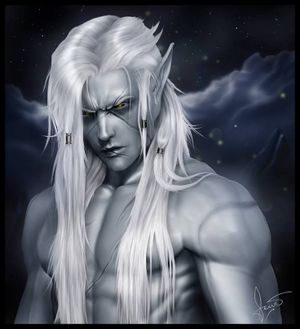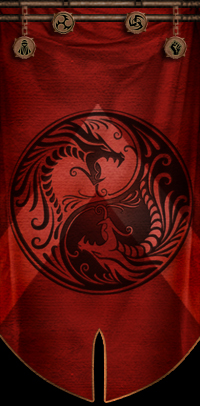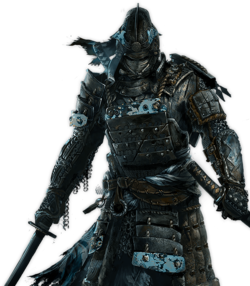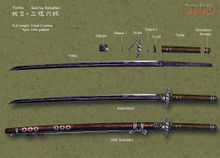 Tamashī Bloodfyre
Tamashī Bloodfyre
- "The most merciful thing in the world, I think, is the inability of the human mind to correlate all its contents. We live on a placid island of ignorance in the midst of black seas of infinity, and it was not meant that we should voyage far. The sciences, each straining in its own direction, have hitherto harmed us little; but some day the piecing together of dissociated knowledge will open up such terrifying vistas of reality, and of our frightful position therein, that we shall either go mad from the revelation or flee from the light into the peace and safety of a new dark age."
- ―The Call of Cthulhu
Antos Jeth, also known by his Shaevalian name, Tamashī Bloodfyre (魂血液火災), was an expert Shaevalian swordsman and rōnin. Tamashī, as he was often simply known, became renowned through stories of his excellent swordsmanship, and served as the captain of the third unit of his clan's Shinsengumi. He was one of the few core members who survived the numerous wars of the Sol shogunate purges of the Sephi clans.
Biography
Pre-Dark Brotherhood
Very little is known for certain about Tamashī before 19ABY, when he begins to appear in surviving documents and letters. His Inquisitor dossier starts in 26ABY but in it Tamashī spoke very little about his past. Born the son of Alaric Jeth, a minor warrior-noble in the service of the Matsudaira Shinobi clan, his father was publicly a retainer of the Sol Shogunate and his mother was the daughter of a priest from Kashima Shrine. He would later earn the nickname Oni no Tamashī (悪魔の魂, Demon Tamashī) because of the fearless tactics he displayed in his fighting.
Though Tamashī was born and raised in Iga, in the Mikawa Province (now Iga-chō, Okazaki, Aichi), he often returned to Iga Province, home of the Jeth family. Antos practiced swordsmanship from the age of nine, starting in the Jikishinkage Ryu tradition. After that he learned Hokushin Ittō-ryū from Inoue Hachirō, who was asked by his father to teach his son. Later his family moved to Iga where he began the Nakanishi-ha Ittō-ryū style of fencing. When he was seventeen, he returned to Shaevalis City and joined the government's Torhan Military Institute and the Yydar School of Spear Fighting under Yamaoka Seizan. From an early age, Tamashī showed dedication and talent in the practice of martial arts. As he grew up, he became well known for two things: his swordsmanship and calligraphy.
According to the kansei chōshū shokafu, a genealogy listing of warriors completed in 30ABY by the Sol Shogunate, Tamashī Bloodfyre gave meritorious services during the Battle of Mikatagahara and became commander of a Matsudaira Shinsengumi Unit consisting of 30 men, during Mikatagahara he captured a Sol spy named Chikuan and when Sol's troops invaded Totomi, Tamashī counter attacked with only 30 men at Tenryu river. During the Sol-Iga War he helped implement the defense of the Shinobi homeland in Iga province in 31ABY against Evandros Sol and fought a valiant but ultimately a hopeless effort to prevent the Iga province from being eliminated by forces under the personal command of Evandros himself in 33 ABY.
With his Clan slaughtered nearly to the last man, and his (to be continued)
The Dark Jedi Brotherhood
The Force Awakens
19 ABY to 30 ABY
- "The Je'daii don't see a division of the light and dark side; instead, they believe a balance is necessary between the two. The Je'daii are like the Titans in Greek mythology who came before the gods. They are beings of great power and ability, but not all-knowing. They struggle with the idea of balance in the Force and know that being out of balance affects their power and the planet Tython itself."
- ―John Ostrander
To be determined
Appearance
 Tamashī Bloodfyre
Tamashī Bloodfyre
Physical Description
Slender and tightly muscled Tamashī's features were sharp as if cut from marble, standing at 1.73 meters and weighing 76 kilos he had full, angular features with high cheekbones and a sharp nose. His eyes were remarkable and disturbing - one moment a deep hue of amber, cat-like and unnerving, the next grey and banded like a snake's; a fell rainbow of colors to match any mood. Like most Sephi, his face was smooth and carried no facial hair, yet several scars mar his otherwise otherworldly looks and he moved with Cat-like grace, balance and cold precision. Although more adept at feats of speed and dexterity rather than brute strength, his wiry and athletic frame still radiated the strength and endurance of a seasoned veteran soldier.
Very little of Tamashī's physical appearance is usually viewed by the general public. Tamashī is almost always wearing his unique and exotic looking armor, the helmet and accompanying death's head mask hiding most of his features and leaving bare only his eyes.
Unique Features
Tamashī Bloodfyre's otherwise unmarked body is marred by the wounds taken during his brutal training and short life. A long curving scar on his left cheek, connects to a deeper scar that crosses his visage from left eye to right cheek. A smaller scar bisects his lips and a further slash runs down his chest - attesting to the merciless regime he put himself through. On his back rests a dark amethyst tattoo, with dark glyph's running down his spine.
Attire
While fashioned in the exotic style of the Shaevalian Empire, the armor Tamashi wore was nevertheless a modernized and top of the line piece. Constructed from plastoid composite plates it was designed using blueprints taken from old Stormtrooper armor. Colored a deep cobalt blue, large rectangular plates hanging from the front and back of the cuirass protected the lower body and upper leg as well as the shoulders and joined with armored glove like sleeves which extended to the shoulder and covered the forearms. Thrust through a belt-like silken sash were two beautifully made curved, slender, single-edged blades signifying to the initiated his status as a warrior-noble; and hanging from the opposite side were two lightsabers seemingly at odds with the ritualized and elaborate outfit.
Rarely, when not wearing his armor, Tamashi can be found wearing traditional Shaevalian clothing.
Tied at the waist and falling approximately to the ankles, it was worn over a kimono and had divided legs, similar to trousers and was looser in the waist and narrower in the leg.
The hakama was secured by four straps: two longer himo attached on either side of the front of the garment, and two shorter himo attached on either side of the rear. The rear of the garment has a rigid trapezoidal section, called a koshi-ita. Below that on the inside is a spoon-shaped component which is tucked into the obi or himo at the rear, and helps to keep the hakama in place.

Hakama have seven deep armored pleats, two on the back and five on the front. The pleats are said to represent the seven virtues of bushido, considered essential to the shaevalian way. Although they appear balanced, the arrangement of the front pleats (three to the right, two to the left) is asymmetrical, and as such is an example of asymmetry in Shaevalian aesthetics.
Warbanner / Personal Standard
The designs on sashimono were usually very simple geometric shapes, sometimes accompanied by Japanese characters providing the name of the leader or clan, the clan's mon, or a clan's slogan. Often, the background colour of the flag indicated which army unit the wearer belonged to, while different divisions in these armies emblazoned their own design or logo on it. However, the presence of the daimyo's mon was used more commonly than the design or logo of the unit, as battles could often get quite large and complicated; being able to recognize friend from foe at a glance is of the utmost importance in battle. Sometimes elite samurai, who were sufficiently famed or respected, had their own personal design or name featured on their sashimono as opposed to that of their division. These stylized designs contrast with the elaborate heraldic devices displayed by some European armies of the same period. (will be rewritten)
Personality & Traits
Personality
- "Let me give you some advice, Captain. It may help you to make sense of the world. I believe you find life such a problem because you think there are the good people and the bad people. You're wrong, of course. There are, always and only, bad people, but some of them are on opposite sides."
- ―Lord Vetinari, Guards! Guards!
Believing in using society and its laws to benefit himself, Tamashī believes that structure and organization elevate those who deserve to rule as well as provide a clearly defined hierarchy between master and servant. To this end, Tamashī supports laws and societies that protect his own concerns. If someone is hurt or suffers because of a law that benefits him, well, too bad. Because he may be forced to honor an unfavorable contract or oath he may have made, Tamashī is usually very careful about giving his word. Once given, he will break his word only if he can find a way to do it legally, within the laws of society. The cliché that there is "No honor among thieves" is false when dealing with Tamashī . He is a person who is driven to attain his goals through force, power, and intimidation. Yet Tamashī stands apart from the norm, with his own personal, code of ethics. He expects loyalty from his minions, punishing disloyalty and treachery with a swift merciful death. Tamashī defines his terms and lives by them, whether anyone else likes it or not.
Powers and Abilities
- "Not all knowledge is pure; some is touched by evil. There are secrets that must remain hidden; forbidden teachings that should remain forever buried. There is a dark side to the Force. Unchecked it brings death and destruction. The Council of First Knowledge is sworn to keep this terrible power from being unleashed, but the influence of the dark side is scattered throughout the galaxy, as are the tools it uses to spread: ancient texts of Sith sorcery; amulets imbued with malevolent energy; tainted crystals that can corrupt the minds of the innocent. Sometimes these artifacts are discovered by accident, and they fall into the hands of unsuspecting victims. They become agents of the dark side, wreaking havoc across the galaxy…unless we get to them in time. We are trained in the handling of dark side artifacts. Some can be destroyed, but others are too powerful and must be safeguarded."
- ―Jedi Master Obba, 980 BBY
Combat
Rather than attempting to fight through the bulky and heavy armor, Tamashī fought with it, utilizing the armor's weight and his powerful body to provide his blows with incredible force, while relying on the main articulation points at the elbows and wrists for precision. With this fighting form, Tamashī regained some of his old agility, and his bladework became brutally effective. He never utilized anything less than a killing blow, and his swordplay demonstrated extraordinary precision, unpredictability, and speed, notwithstanding the two-handed grip he typically favored. Even his most simplistic moves contained enough strength to nearly disarm his opponents. The additional weight and bulk of Tamashī 's armor made engaging in Ataru-esque acrobatics considerably more difficult, and he typically refrained from making use of such maneuvers. He was however, still fully capable of performing such acrobatics when pressed.
While he utilized his customized style to great effect, even against multiple opponents, Tamashī occasionally eschewed precision and refinement for strength oriented offensive barrages, however, despite his skill, Tamashī 's method was not perfect. Particularly during situations where he believed himself to be facing an inferior opponent, Tamashī could be taken off-guard or frustrated, causing lapses in his usually staunch defense.
TBD
The Force
Equipment

Armor
While fashioned in the exotic style of the Shaevalian Empire, the armor Tamashi wore was nevertheless a modernized and top of the line piece. Constructed from plastoid composite plates it was designed using blueprints taken from old Stormtrooper armor. Colored a deep cobalt blue, large rectangular plates hanging from the front and back of the cuirass protected the lower body and upper leg as well as the shoulders and joined with armored glove like sleeves which extended to the shoulder and covered the forearms.
A neck guard made from several layers of curved iron was suspended from the bottom edge of the helmet. Lacquered metal designed in a way that the top heavy helmet could be tied and secured by metal posts along with a throat guard made from several rows of leather plates and chainmail sewn to a cloth backing, was suspended from the bottom edge. Thigh guards which tied around the waist and covered the thighs were made from cloth with small iron and leather plates, connected to each other by chain armor and sewn to the cloth. Thrust through a belt-like silken sash were two beautifully made curved, slender, single-edged blades signifying to the initiated his status as a warrior-noble; and hanging from the opposite side were two lightsabers seemingly at odds with the ritualized and elaborate outfit.
Weapons

Katana: Characterized by its distinctive appearance: a curved, slender, single-edged blade with a circular or squared guard and long grip to accommodate two hands, the blade is 73 cm (28½ in) long. The quicker draw of the sword was well suited to combat where victory depended heavily on fast response times. The katana further facilitated this by being worn thrust through a belt-like sash (obi) with the sharpened edge facing up. Ideally, Tamashī could draw the sword and strike the enemy in a single motion. Previously, the curved tachi had been worn with the edge of the blade facing down and suspended from a belt.

Shortsword: The blades length is 36.8 cm (14½ in) and was used as a backup or auxiliary sword; it was also used for close quarters fighting, to behead a defeated opponent and sometimes to commit seppuku, a ritual suicide. The smaller blade being worn together with a katana was the official sign that the wearer was a noble-born swordsman of feudal Shaevalis. When worn together the pair of swords were called daishō, which translates literally as "big-little". The katana was the big or long sword and the shortsword the companion sword.
Notes and References
Name
- "“It is spiritless to think that you cannot attain to that which you have seen and heard the masters attain. The masters are men. You are also a man. If you think that you will be inferior in doing something, you will be on that road very soon.”"
- ―Tsunetomo Yamamoto, Hagakure: The Book of the Samurai[1]
A samurai was usually named by combining one kanji from his father or grandfather and one new kanji. Samurai normally used only a small part of their total name.
For example, the full name of Oda Nobunaga would be "Oda Kazusanosuke Saburo Nobunaga" (織田上総介三郎信長), in which "Oda" is a clan or family name, "Kazusanosuke" is a title of vice-governor of Kazusa province, "Saburo" is a formal nickname (yobina), and "Nobunaga" is an adult name (nanori) given at genpuku, the coming of age ceremony. A man was addressed by his family name and his title, or by his yobina if he did not have a title. However, the nanori was a private name that could be used by only a very few, including the Emperor.
Samurai could choose their own nanori, and frequently changed their names to reflect their allegiances.
References